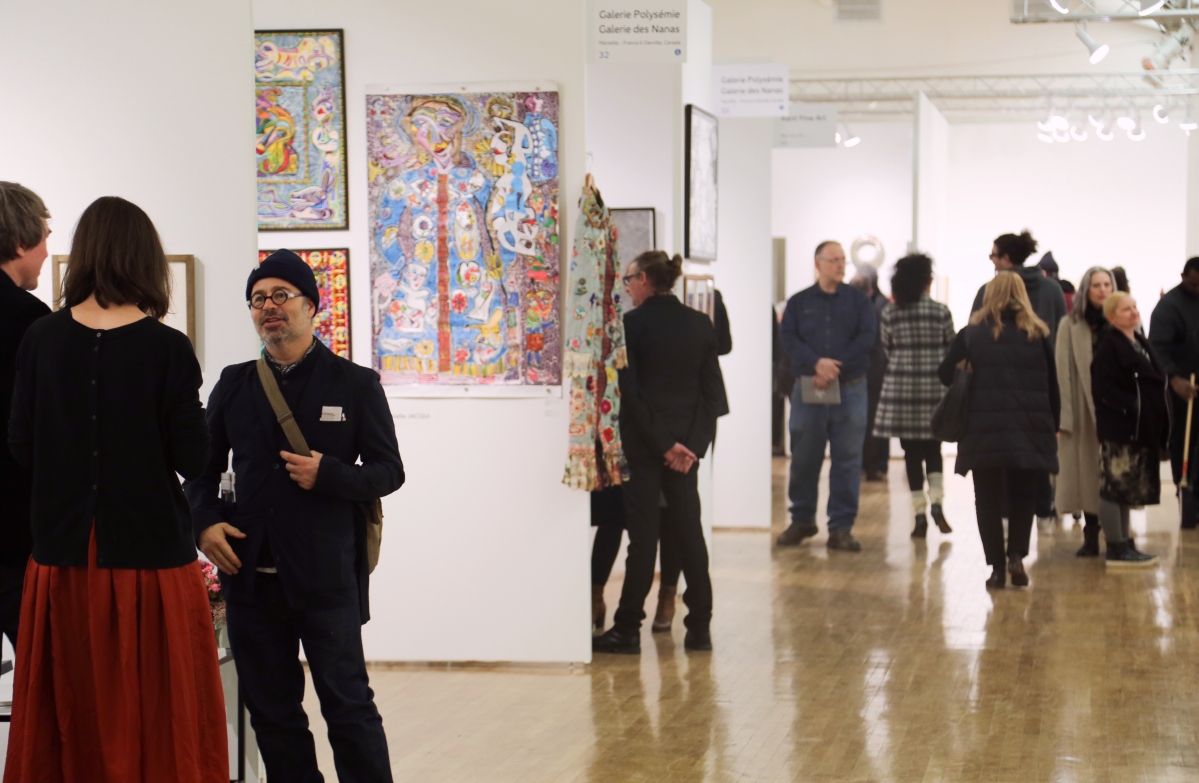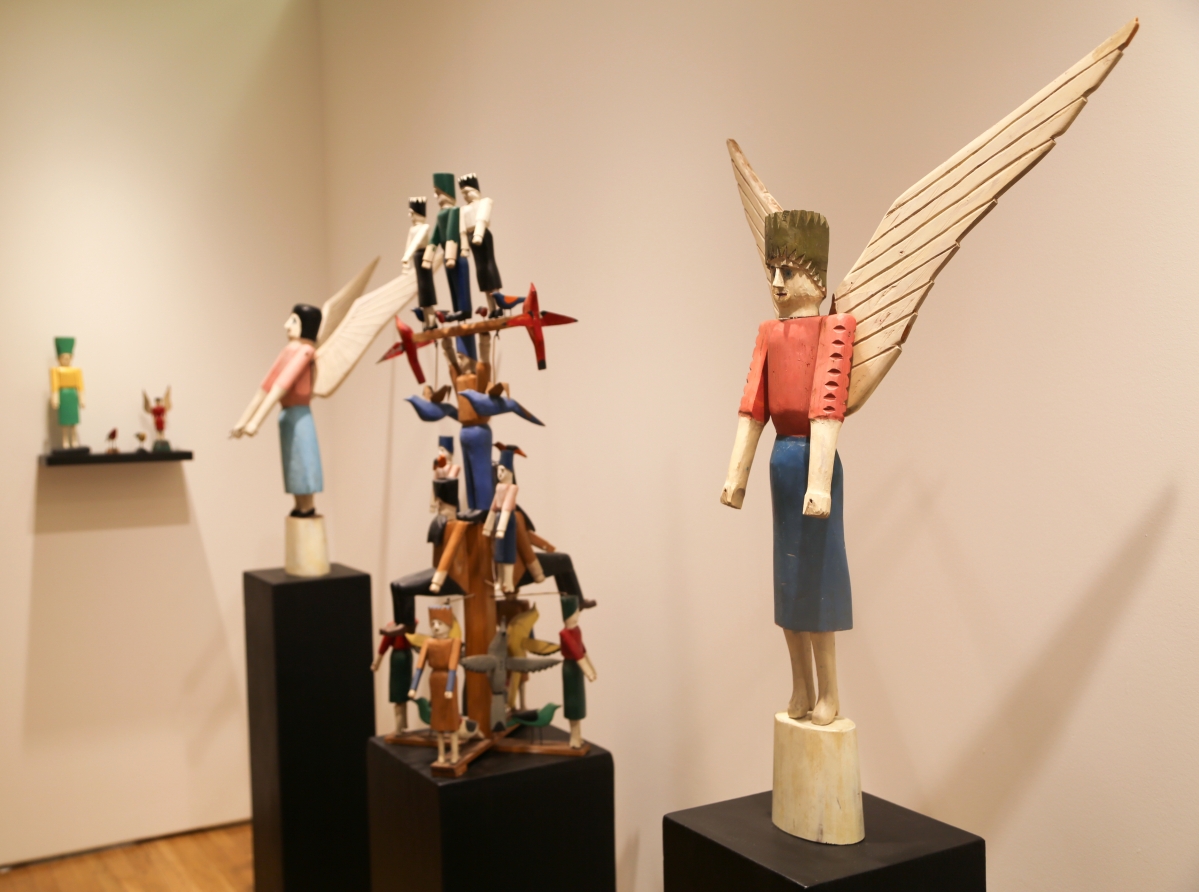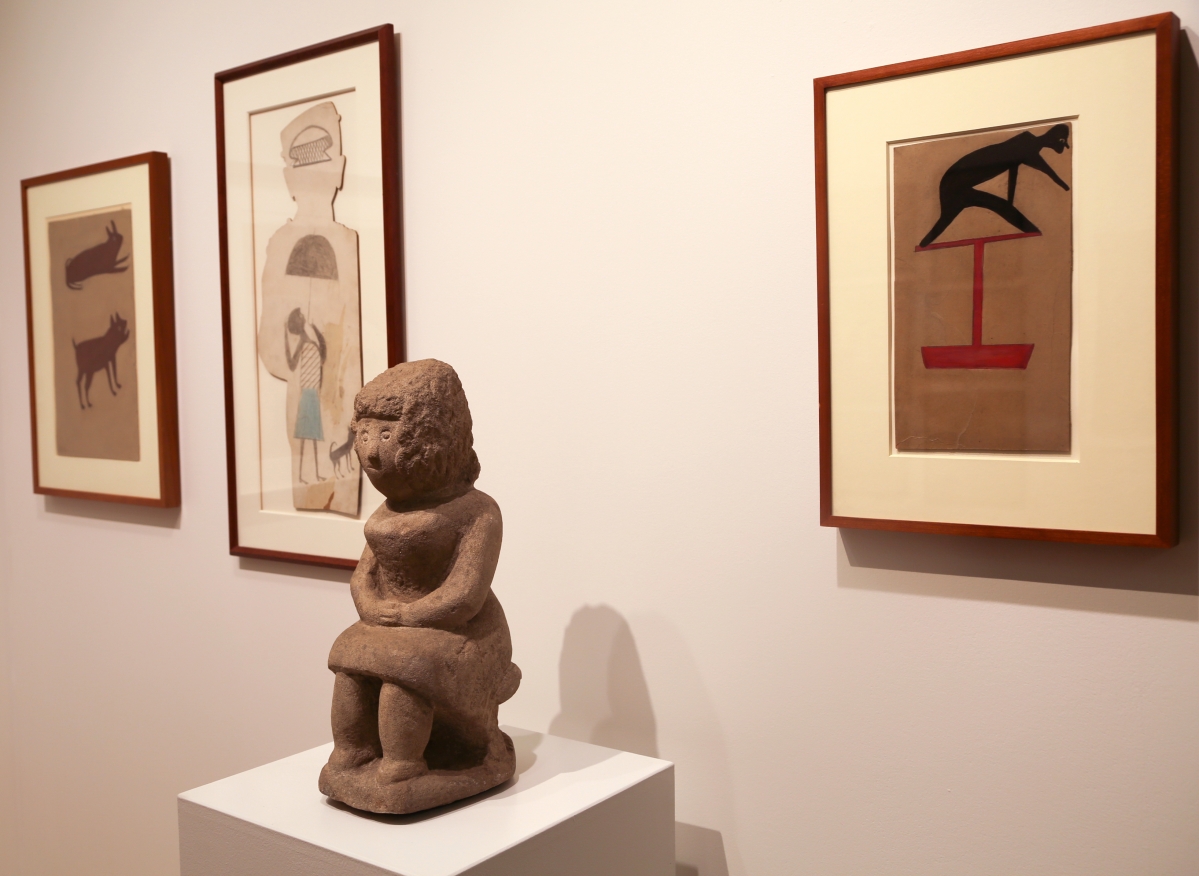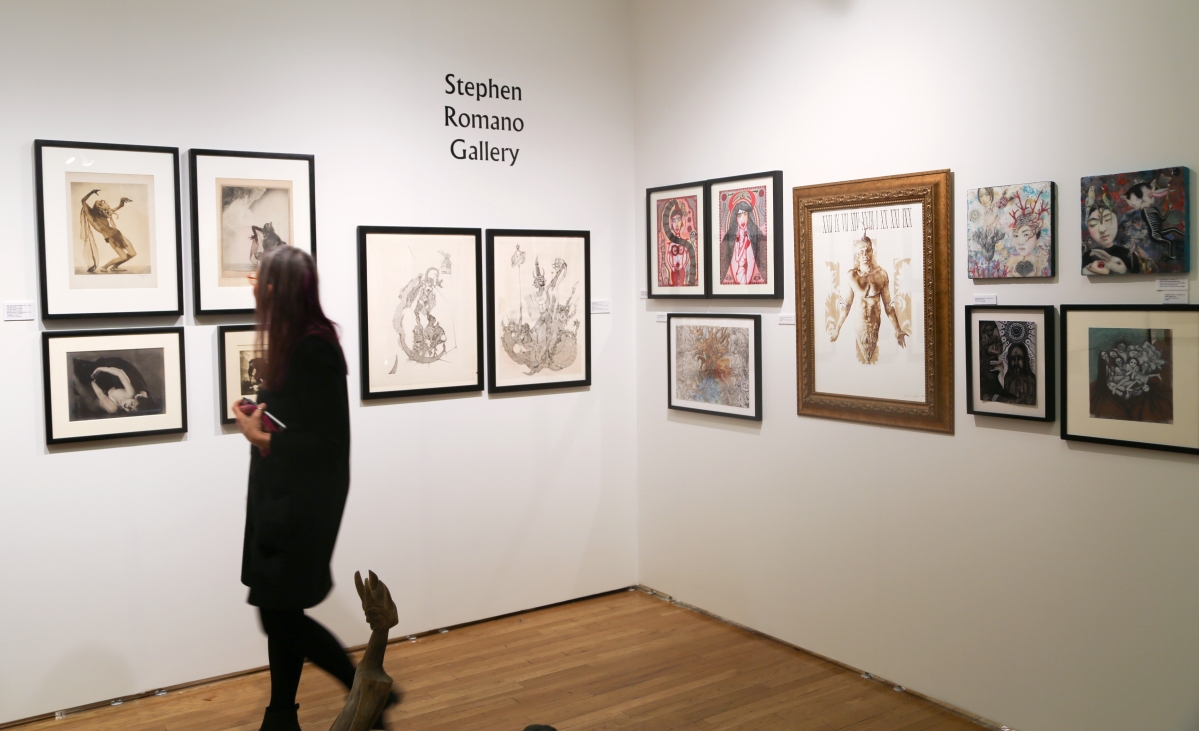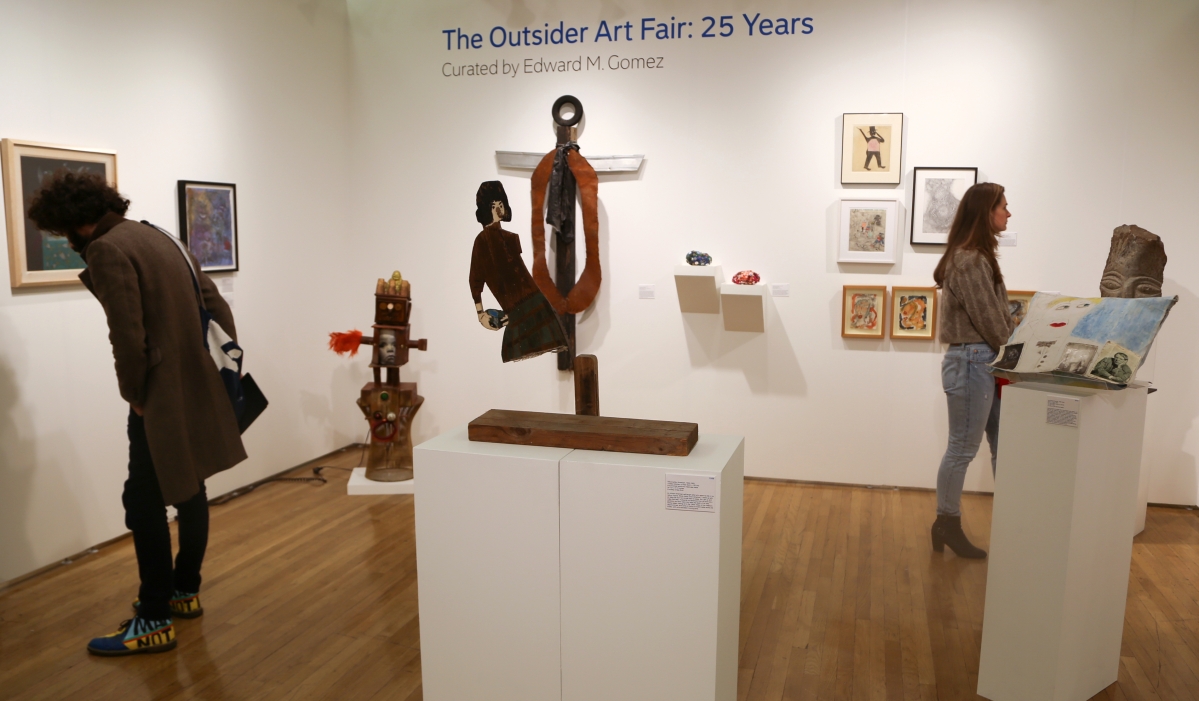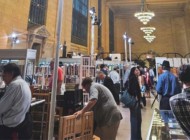
Carl Hammer Gallery, Chicago, exhibited the carved and painted sculpture of Wisconsin artist Albert Zahn.
Review and Photos by Greg Smith
NEW YORK CITY – Steps echoed over the hardwood floor at the Outsider Art Fair as the show celebrated its 25th anniversary at the Metropolitan Pavilion January 19-22. Outsider Art has seen a sharp increase in interest over the past few years, with the credit due largely to the very galleries at this fair who have focused their efforts in bringing recognition to the self-taught art genre. With secondary market prices reaching record heights for works by Bill Traylor, William Edmondson, Henry Darger and others, the art world is watching its baby grow into a beau. Whether the thirst has trickled in from the contemporary art market or onlookers find romance in the uninhibited style that accompanies the genre, more buyers are looking at outsiders as the new in.
“These artists are uninformed by art history,” said Andrew Edlin, the show’s owner. “They don’t have the filters on their work to make them feel self-conscious.”

Show owner Andrew Edlin, left, and Sandy Smith, the fair’s original founder. Smith said, “Andrew has done a wonderful job expanding the Outsider Art Fair while keeping it true to it’s original intent and purpose.”
More than 60 dealers filled their booths with lively displays of fine art including sculpture, ceramics, paintings, drawings and objects that transcended contemporary works to American folk art.
“The work is so personal because many of the artists have created a very elaborate interior universe,” said Edlin. “Darger and Wölfli created these epic tails and placed themselves in the center of their own stories.”
A personal universe is a common theme for many of the artists at the fair, some of which resulted from psychosis or other mental disorders. Others found their creativity through isolation, their insularity building a body of artwork that oftentimes marginalized them during their lifetime, earning them the label of “eccentric.”
Carl Hammer Gallery, Chicago, exhibited three carved and painted wood sculptures by Albert Zahn (American, 1864-1953). During his lifetime, Zahn’s many sculptures were displayed in an art environment outside his residence in Wisconsin, which he dubbed “Bird’s Park” after the numerous carved and painted birds he made in addition to other animals and biblical figures. His work received little recognition during his lifetime and was picked apart by community members, only to be bought back slowly once his work received attention in the late Twentieth Century. His home was registered on the National Register of Historic Places in 2000.
Contemporary artist Jordan Maclachlan exhibited her “Unexpected Subway Living” series at Marion Harris, New York City. The clay figures depicted scenes of men, women, children and animals living their lives underground in the subway, as their homes had vanished and above-ground living was not possible. The expansive body of work includes more than 300 pieces, ranging from figures making love on subway seats to a butcher’s meats offered for sale to a Minotaur casually sitting and reading the newspaper or a deer standing with attention perked atop another two-seat row. All sorts of animals are present in Maclachlan’s universe, and her placard read “Some species are more equal than others… especially humans.”
“He was a complicated guy,” said Tom Parker of Hirschl & Adler Modern, New York City, regarding artist Frank Walter (Antiguan, 1926-2009), the subject of the dealer’s solo show at the fair. Walter lived alone in a self-built house on a hill in Antigua without running water or electricity for the latter part of his life. The artist worked on found objects to create sculpture, painting and constructions, as well as practicing portrait photography and writing, with more than 25,000 written pages found after his death. Walter largely marginalized himself from his fellow Antiguans with his adamant belief that he was white, when he was, in fact, black. His idyllic paintings on Polaroid cartridges featured landscapes around the island, calm bays and the bright sunsets.
On the connection between American folk art and outsider art, Steve Powers of Steven S. Powers Works of Art & Americana, Brooklyn, New York, said, “The relationship is in the term ‘self-taught.'” The dealer mounted the exhibition “Small Faces Unbound,” bringing in objects and art spanning 80 to 150 years old. Powers wrote, “We focused on indelible visages – stark, psychological and philosophical – existential and mythological, some animal, some mysterious and some absurd.”
Sitting in the center of the booth was a vivid terracotta toddler sculpture, found in Ohio, sitting on a thick stool in perfect posture with an attentive, wanting expression. On a nearby wall were paintings by Maine artist George E. Morgan, a man who had worked in a shoe factory and taught himself to paint in his 90s. Morgan’s primitive images include classical American folk art scenes: a church choir centered in a garden of colorful flowers, a muted village center scene and a bird’s-eye view of the railroad station in Gardiner, Maine.

The colorful geometrics of Oskar Jonsson lured attendees into the booth of Luise Ross Gallery, New York City.
“Ninety percent of the people I saw were new to me and I was new to them,” said Powers. “Their unfamiliarity with my material presented a learning curve, but they weren’t intimidated to ask about something they didn’t understand. The fair was by far the most well-attended show I have ever done – the environment was charged.”
Aarne Anton of American Primitive Gallery, New York City, has been exhibiting at the show since it started 25 years ago. Anton featured the wild animals of Florida artist Reverend O.L. Samuels. A decorated elephant with a long trunk and hidden hinges allowed the work’s head to open and the body to be used as storage. The artist was afraid of being stolen from. A tense, maned cat with sharp teeth by Samuels was prowling next to it. The artist began working in wood when he was bound to a wheelchair after a tree-cutting accident. His grandmother had once told him to carve wood when he was feeling down, so he did. Behind the animals were painted works by Ionel Talpazan, a Romanian refugee to the United States whose encounter with a UFO early in life largely directed the subject of his artwork. Talpazan’s entire body of work focuses on elaborate cross sections of different kinds of alien ships.
“Brilliance and genius reside in the most unlikely places,” said Andrew Edlin. “You can never underestimate anyone, and that’s really exciting.”
The Outsider Art Fair will return to New York City in 2018. For additional information, www.outsiderartfair.com or 212-337-3338.





